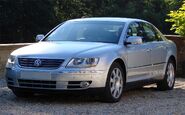| This article needs additional citations for verification. Please help improve this article by adding citations to reliable sources. Unsourced material may be challenged and removed. (November 2011) |
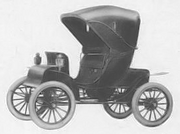
1908 Fritchle Victoria Phaeton - much like the namesake carriage
A Phaeton is a style of open car or carriage without proper weather protection for passengers.
It is not a convertible. A convertible has wind-up windows in its doors and may be converted from open to fully closed. A convertible is by nature much heavier.
Side protection may be supplied to a phaeton by clipping on flexible sidescreens where there are no windows. Phaeton bodywork is by its nature much lighter than convertible bodywork or a sedan and so it is suitable if speed is important. Because the body was entirely open it was easy to add or remove an extra row of seating where space had been left in the original construction.
Origin of the term[]
- Main article: Phaëton
The term phaeton had earlier referred to a light, open four-wheeled carriage, which again referreds to the disastrous ride of the mythical Phaëton, son of Helios, who set the earth on fire while attempting to drive the chariot of the sun.
History[]
- See also: Phaeton (carriage)
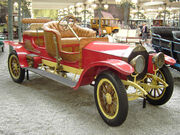
1905 Mercedes 28/50 PS Double Phaeton
In automotive terms, the phaeton was originally a light two-seater with minimal coachwork, similar to a racing car. The term was interchangeable with spyder,[1] which may be due to the spyder's origin in the spider phaeton.[citation needed] However, there were also double phaetons, with two rows of seats, triple phaetons, or even closed phaetons.[1][2] Eventually, the term "phaeton" became so widely and loosely applied that almost any vehicle with two axles and a row or rows of seats across the body could be called a phaeton.[2]
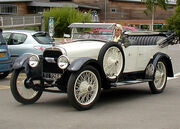
1917 Hudson Phaeton
After 1912, American use of the term began to be most closely associated with the "triple phaeton" body configurations that had room for three ("rows" of) seats whether or not all three were installed. Common usage further evolved to refer to a car body style where the rear seat area was extended for added leg room or for an additional row of seating. This often gave the vehicle the appearance that it was meant to be chauffeur-operated. This led to the term "phaeton" becoming similar to, and eventually interchangeable with, the term "touring car".[3] This body type was popular up to the early years of World War II.

Cadillac V16 1932 with dual cowl
A specific use of the term "phaeton" is with the dual cowl phaeton, a body style in which the rear passengers were separated from the driver and the front passengers by a cowl or bulkhead, often with its own folding windshield.
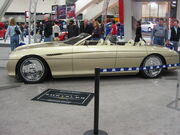
Chrysler Phaeton concept car. The center bulkhead and windshield make this open car a dual-cowl phaeton
The phaeton and the touring car were ultimately supplanted by the convertible, an open car which could be fully closed with windows in the doors. The Chrysler Phaeton concept car shows what a modern phaeton might look like.
Examples of phaetons[]
Examples of dual cowl phaetons[]
Cars called "phaeton"[]
After open cars disappeared from the market, manufacturers used the term "phaeton" to describe cars that resembled the open phaeton or touring car. Buick advertised a "convertible phaeton" body style which was actually a four-door convertible, as the doors had windows in them and the car could be fully closed.[4] In 1956, Mecury marketed the four-door hardtop versions of its Montclair and Monterey as phaetons.[5]
In 2004, Volkswagen introduced their flagship vehicle with the name Phaeton, despite the car not resembling an open car in any way.
Examples of later cars called "phaetons"[]
Notes[]
- ↑ 1.0 1.1 Roberts, p.111
- ↑ 2.0 2.1 Terry 1914: 2
- ↑ Webster's Third New International Dictionary of the English Language, Unabridged, p.2417, Merriam, 1961
- ↑ "Buick brochure". Img.inkfrog.com. Retrieved on 2011-11-20.
- ↑ 5.0 5.1 Luce, Henry R., ed. (July 23, 1956), "80 Mercury Phaetons Free", Life (Chicago IL USA: Time Inc.) 41(4): 92. ISSN 0024-3019, http://books.google.com/books?id=5EgEAAAAMBAJ&printsec=frontcover&dq=cadillac+phaeton&hl=en&ei=QS_HTteaPIfGmQXL9oEa&sa=X&oi=book_result&ct=result&resnum=5&ved=0CD8Q6AEwBDge#v=onepage&q=phaeton&f=false. Retrieved on .
References[]
- (1966) Webster's Third New International Dictionary of the English Language, Unabridged L-Z. Springfield, Mass. USA: G & C Merriam, 2417. ISBN 0-7135-1037-4.
- Roberts, Peter (1974). "Carriage to Car", Veteran and Vintage Cars. London, UK: Octopus Books, 111. ISBN 0-7064-0311-2. “Phaeton – A light car with seats for two and the minimum of coachwork, similar to an early racing car. Phaetons could be double (four seats), triple, or closed. Sometimes also calles a spider, or spyder.”
- Terry, Christopher W.; Arthur Hall (1914). "The Varieties of Motor Bodies", Motor Body-building in All Its Branches. London: E. & F. N. Spon, ltd, 1–6.
| This page uses some content from Wikipedia. The original article was at Phaeton body. The list of authors can be seen in the page history. As with Tractor & Construction Plant Wiki, the text of Wikipedia is available under the Creative Commons by Attribution License and/or GNU Free Documentation License. Please check page history for when the original article was copied to Wikia |
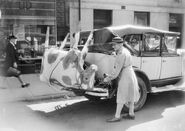




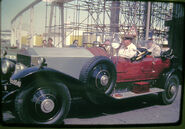



![1956MercuryMontclair.jpg (1.02 MB) 1956 Mercury Montclair Phaeton[5] 4-door hardtop](https://static.wikia.nocookie.net/tractors/images/3/3b/1956MercuryMontclair.jpg/revision/latest/scale-to-width-down/185?cb=20130225171555)
